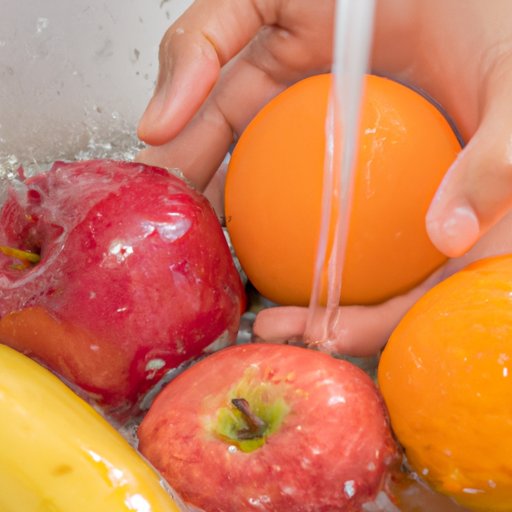
How to Wash Fruit: A Step-by-Step Guide
If you are what you eat, then it is essential to make sure that the food you consume is healthy. Fruits are considered to be one of the healthiest foods, being packed with beneficial nutrients and vitamins. However, they can also be harboring harmful chemicals or bacteria, which is why it is important to wash them properly before consuming or handling them. In this article, we will provide a comprehensive guide on how to wash fruits thoroughly, including tips on choosing the right type of soap or cleaning agent and suggestions of natural ingredients to use.
Why is it important to wash fruits?
Fruits can be contaminated with bacteria, pesticides, or other chemicals during their growth, harvesting, or transportation. These contaminants can cause a wide range of illnesses, from mild stomachaches to severe illnesses, such as food poisoning. Multiple studies have also found that washing fruit is an effective way of removing pesticides and other harmful chemicals.
Not to mention, washing fruits also removes dirt and debris that may have accumulated on the surface. Regardless of whether you are planning to eat the peel, such as in apples or pears, or not, proper washing ensures that everything you eat is clean and safe.
Step-by-step guide on how to wash fruits thoroughly
Washing fruit is a simple process, but it is essential to follow the correct steps to ensure that it is done efficiently. Here is a step-by-step guide on how to wash fruits thoroughly:
Step 1: Wash your hands. Before you start washing fruit, it is essential to wash your hands thoroughly with soap and water. This will prevent the spread of any bacteria that might be on your hands.
Step 2: Rinse. Start by rinsing the fruit under cool running water for at least 30 seconds. If you are washing berries or other small fruits, place them in a colander and rinse them under the tap.
Step 3: Scrub. Use a vegetable brush to scrub the fruit gently, if necessary. Some fruits, such as apples or peaches, may have a wax coating on their surface. Scrubbing these fruits with a brush can help remove the waxy coating and any dirt or debris that has accumulated on the surface.
Step 4: Rinsing again. After scrubbing, rinse the fruit once again under cool running water to remove any remaining dirt or soap.
Step 5: Drying. Pat the fruit dry with a clean towel before eating or storing it.
Tips on choosing the right type of soap or cleaning agent and the proper washing technique
While washing fruits with plain water is effective, some people prefer to use soap, detergents or commercial fruit spray to clean their fruits thoroughly. Here are some tips on choosing the right cleaning agent and proper washing technique:
– Commercial fruit cleaners/sprays: These products are specially formulated to remove bacteria and pesticides. However, they can be expensive, and some people may be sensitive to certain chemicals. If you choose to use commercial products, read the instructions carefully and follow them precisely.
– Vinegar: White vinegar is a natural and effective cleaning agent. To use it, mix equal parts of water and vinegar in a bowl, and dip the fruit in the mixture, rinsing it off afterward.
– Baking soda: Baking soda is another natural cleaning agent, extensively used in households. To use it, mix two teaspoons of baking soda in a bowl of water, dip the fruit in the mixture, and rinse it off afterward.
When using cleaning agents, make sure not to use hot water or soak fruit for extended periods. Hot water may cause the fruit to soften or cook slightly, while extended soaking may lead to the loss of nutrients.
Suggestions of natural ingredients to use in washing fruit
Besides commercial fruit cleaners and natural cleaning agents, several natural ingredients can be effective in washing fruits. Here are some natural options:
– Lemon juice: Lemon juice is a natural cleansing agent that can remove bacteria and dirt. To use it, squeeze a fresh lemon onto the fruit or mix it with water and use it to rinse the fruit.
– Salt: Salt is a natural ingredient with antimicrobial properties and can be used in a mildly abrasive scrub. Mix two teaspoons of salt with water and use it to scrub the fruit gently, rinse it off afterward.
Personal stories or interviews with agriculture experts
Personal stories or interviews with agriculture experts are an excellent way to highlight the importance of washing fruits. Some individuals have suffered from unpleasant experiences such as contracting foodborne illnesses resulting from consuming unwashed fruit. These personal stories offer valuable insights on the significance of washing fruits properly. Similarly, agriculture experts can provide critical information on the impact of unwashed and contaminated fruit on the environment, and how washing fruit can play a role in conservation efforts.
Conclusion
Given the benefits and advantages of eating fruits, it is essential to ensure that they are thoroughly washed. By following the simple steps and tips provided in this article, you can enjoy the taste and benefits of clean fruits, free from harmful chemicals or bacteria. Incorporating proper fruit washing into your daily routine is a small step that can significantly contribute to healthy eating habits.





